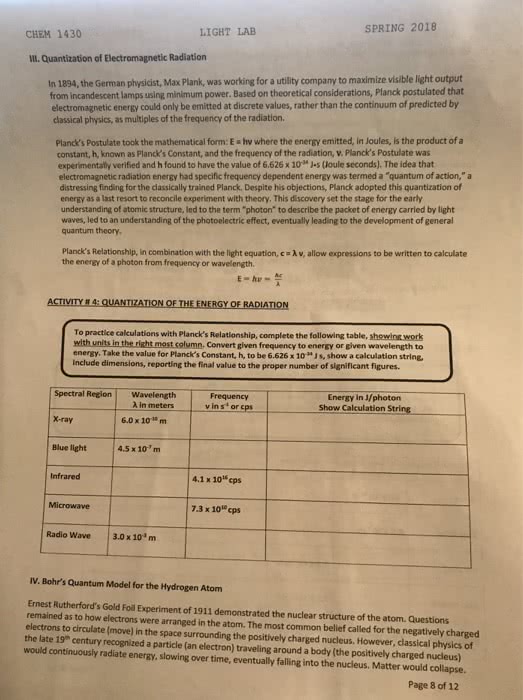CHEM1101 Lecture Notes - Lecture 2: Photon Energy, Bohr Model, Black-Body Radiation

Developed to explain experimental observations that could not be understood using classical theories of
physics
○
Blackbody radiation
1.
Heat --> oscillation of charges, electromagnetic radiation
-
Classically energy was continuous
-
Max Planck proposed that energy is quantized
-
E=hv (v=freq of oscillation, h= Planck's constant)
-
Quantum theory
•
Properties of the quantum world
Photoelectric effect (light has particle nature)
2.
Classically (for light as a wave), energy is proportional to square of its amplitude
-
For particles - energy proportional to frequency
-
Einstein proposed light has particle nature (and wave nature) ie light is quantized (photons)
-
Shows energy of light is dependent on its freq and intensity
-
Light can eject electrons from a metal , but only if its freq is above a threshold freq (characteristic of each
metal)
-
In summary….
Light is electromagnetic radiation that has both wave and particle (photons) nature
-
Spectroscopic lines
3.
Visible atomic emission spectra - discrete spectral wavelengths (called "lines")
-
Bohr proposed atomic model, where electrons in discrete orbits
-
So atom cannot lose energy continuously, but must do so in quantum jumps between different orbits
-
Light emitted by an excited atomic gas consists of discrete wavelengths, not a continuous band
-
Bohr model: set of circular orbits for e- with specific, discrete radii and energies. e- can move in each orbit
without radiating energy
-
Since moving charged particles radiate energy, thus e- should continually lose energy and spiral into the
nucleus
▪
Only applied to single-electron atoms
▪
BUT! Bohr model raised problems
-
continuous
Packets of energy
-
particles
-
Discrete/quantized
Quantum theory
Friday, 31 March 2017
11:51 PM
2. Wave theory of electrons + atomic energy levels Page 1

Only applied to single-electron atoms
▪
Couldn't say why an e- should have discrete orbits or energies
▪
Each frequency absorbed or emitted by an atom corresponds to a particular energy change for the atom.
Characteristic patterns provide info about atomic structure
-
Emitted photons
-
Electrical discharge excites atoms from their ground state (lowest energy) into higher energy states (excited
state)
-
Excited atoms then lose all or part of their excess energy by emitting photons
-
Emitted light can be passed through a prism to give an emission spectrum
-
Lines in diagram correspond to photons emitted by the hydrogen atoms as they return to their ground state
-
Emission spectrum
Wave behaviour and restricted motion (ie. Wavelength, amplitude), lead automatically to discrete energy levels or
frequencies
-
Matter wave concept explains why e- have discrete energy levels
-
Mechanics of waves
2. Wave theory of electrons + atomic energy levels Page 2

Calculate the energy of a photon from its wavelength and its wavelength from its
energy
Amount of energy (quantum) in each photon is determined by its frequency v(nu) or wavelength λ (lambda)
•
Speed of light - c, is usually given as
•
C = 3.0 x 108m/s
Wavelength = λ (in m, cm etc.)
Frequency = v (usually in MHz)
2.1
Wednesday, 24 May 2017
6:23 PM
2. Wave theory of electrons + atomic energy levels Page 3
Document Summary
Developed to explain experimental observations that could not be understood using classical theories of physics. E=hv (v=freq of oscillation, h= planck"s constant) continuous. Classically (for light as a wave), energy is proportional to square of its amplitude. Einstein proposed light has particle nature (and wave nature) ie light is quantized (photons) Shows energy of light is dependent on its freq and intensity. Light can eject electrons from a metal , but only if its freq is above a threshold freq (characteristic of each metal) Light is electromagnetic radiation that has both wave and particle (photons) nature. Visible atomic emission spectra - discrete spectral wavelengths (called lines) Bohr proposed atomic model, where electrons in discrete orbits. So atom cannot lose energy continuously, but must do so in quantum jumps between different orbits. Light emitted by an excited atomic gas consists of discrete wavelengths, not a continuous band.


